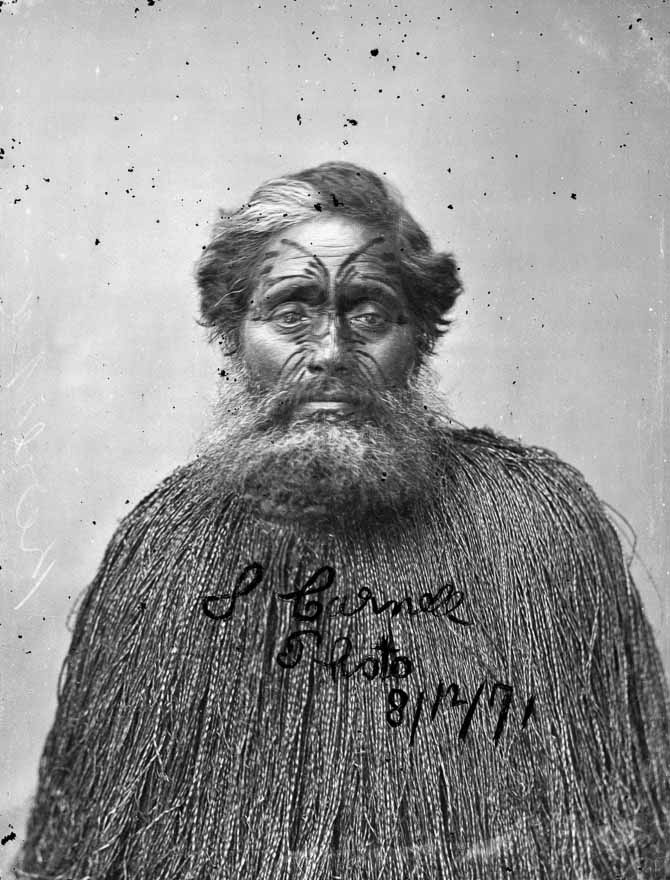
This photograph of Kereopa Te Rau was taken in Napier prison in December 1871.
Kereopa Te Rau was one of the five original disciples of Te Ua Haumēne, the founder of the Pai Mārire faith. He was a member of Ngāti Rangiwewehi of Te Arawa. This image was taken not long before he was hanged at Napier on 5 January 1872 for the murder of Carl Völkner.
Kereopa had fought in the Kingite forces during the Waikato War. His wife and two daughters are thought to have been killed at Rangiaowhia, near Te Awamutu, when the kāinga was attacked by government forces on 21 February 1864. The following day he saw his sister killed at nearby Hairini. Following his conversion to Pai Mārire he joined Pātara Raukatauri in taking the faith to the East Coast. Pātara allegedly took the head of a soldier killed in an ambush near Te Ahuahu, Taranaki with him on this mission. Te Ua told them to preach peacefully in the areas they passed through; Pākehā were not to be disturbed. Perhaps because of his recent experiences, Kereopa was reluctant to comply. Twice he demanded unsuccessfully that Europeans be given up to him.
When the missionary Carl Völkner was seized and ritually killed at Ōpōtiki on 2 March 1865 Kereopa swallowed his eyes, calling one eyeball ‘Parliament’ and the other the ‘Queen and British law’. He later repeated this act on the bodies of three Ngāti Manawa warriors who had been decapitated, earning the name Kaiwhatu (the eye-eater).
In May 1865 Kereopa was prevented from travelling to Waikato to preach to the Kingite tribes by a force of Ngāti Manawa and Ngāti Rangitihi. He returned to Ōpōtiki but in the spring was driven deep into Tūhoe country after government troops arrived. With support from Tūhoe (as the bearer of the Pai Mārire faith to that tribe he had obtained their protection) and the protection of the dense bush of the Urewera mountains, Kereopa was able to elude his pursuers for five years.
From mid-1868 Te Kooti’s new Ringatū faith gained popularity among Tūhoe and the influence of Pai Mārire declined. The relentless pursuit of Te Kooti and the remaining Hauhau leaders took a severe toll. Between May 1869 and early 1872 Tūhoe land was devastated by several invasions by government troops and a Ngāti Porou force led by Rāpata Wahawaha. Pā were plundered, crops destroyed and many people killed. By late 1870 several Tūhoe leaders had made peace with the government. While they were unwilling to violate the sanctuary of the Urewera by giving up Kereopa, they were keenly aware of the risk of further invasion if he remained among them. Having decided to withdraw their protection, they chose to deliver him to the government themselves to retain their mana. In September 1871 Kereopa agreed to give himself up as ‘payment for the Tūhoe blood that had been shed for him’. He then tried to escape but was captured by one of the Tūhoe party sent to collect him. Having broken his word, he was handed over to Rāpata and Captain Thomas Porter.
Kereopa was convicted of the murder of Völkner at the Supreme Court at Napier in December 1871. A European witness, Samuel Levy, testified that he had seen Kereopa among those who escorted Völkner to the willow tree from which he was hanged. The former missionary William Colenso appealed unsuccessfully for clemency on the grounds that the crime had already been punished by executions and land confiscation. Mother Mary Aubert, of Father Reignier’s mission at Napier, stayed with Kereopa during his last night. It was Reignier who had baptised Kereopa as a Roman Catholic 30 years earlier. Kereopa was hanged on 5 January 1872 at Napier. In 2014, as part of the settlement of Ngāti Rangiwewehi’s Treaty of Waitangi claim, Kereopa was pardoned for his role in the death of Völkner.

Community contributions